
This is a list of buns. A bun is a small, sometimes sweet, bread, or bread roll. Though they come in many shapes and sizes, they are most commonly hand-sized or smaller, with a round top and flat bottom.

This is a list of buns. A bun is a small, sometimes sweet, bread, or bread roll. Though they come in many shapes and sizes, they are most commonly hand-sized or smaller, with a round top and flat bottom.
A
B

C

D
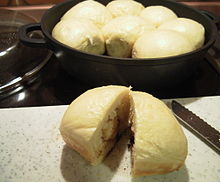
F
H

I
J
K
L
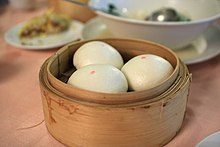
M
N
P
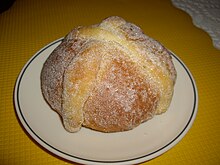
Q
R
S
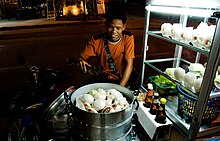
T

W
X
Z

Pastry is baked food made with a dough of flour, water, and shortening that may be savoury or sweetened. Sweetened pastries are often described as bakers' confectionery. The word "pastries" suggests many kinds of baked products made from ingredients such as flour, sugar, milk, butter, shortening, baking powder, and eggs. Small tarts and other sweet baked products are called pastries as a synecdoche. Common pastry dishes include pies, tarts, quiches, croissants, and pasties.

A bun is a type of bread roll, typically filled with savory fillings. A bun may also refer to a sweet cake in certain parts of the world. Though they come in many shapes and sizes, buns are most commonly round, and are generally hand-sized or smaller.
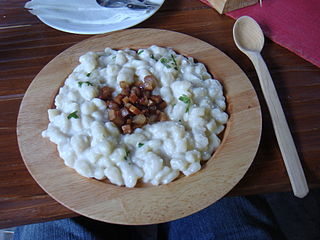
Slovak cuisine varies slightly from region to region across Slovakia. It was influenced by the traditional cuisine of its neighbours and it influenced them as well. The origins of traditional Slovak cuisine can be traced to times when the majority of the population lived self-sufficiently in villages, with very limited food imports and exports and with no modern means of food preservation or processing.

A pineapple bun is a kind of sweet bun predominantly popular in Hong Kong and also common in Chinatowns worldwide. Despite the name, it does not traditionally contain pineapple; rather, the name refers to the look of the characteristic topping.

Czech cuisine has both influenced and been influenced by the cuisines of surrounding countries and nations. Many of the cakes and pastries that are popular in Central Europe originated within the Czech lands. Contemporary Czech cuisine is more meat-based than in previous periods; the current abundance of farmable meat has enriched its presence in regional cuisine. Traditionally, meat has been reserved for once-weekly consumption, typically on weekends.

Cha siu bao is a Cantonese baozi (bun) filled with barbecue-flavored cha siu pork. They are served as a type of dim sum during yum cha and are sometimes sold in Chinese bakeries.

The Chelsea bun is a type of currant bun that was first baked in the 18th century at the Bun House in Chelsea, an establishment favoured by Hanoverian royalty accustomed to similar pastries in their native cuisine. The shop was demolished in 1839.
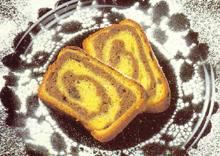
A nut roll is a pastry consisting of a sweet yeast dough that is rolled out very thin, spread with a nut paste made from ground nuts and a sweetener like honey, then rolled up into a log shape. This 'log' is either left long and straight or is often bent into a horseshoe shape, egg washed, baked, and then sliced crosswise. Nut rolls resemble a jelly roll but usually with more layers of dough and filling, and resemble strudels but with fewer and less delicate dough layers. Fillings commonly have as their main ingredient ground walnuts or poppy seeds.

Kue is an Indonesian bite-sized snack or dessert food. Kue is a fairly broad term in Indonesian to describe a wide variety of snacks including cakes, cookies, fritters, pies, scones, and patisserie. Kue are made from a variety of ingredients in various forms; some are steamed, fried or baked. They are popular snacks in Indonesia, which has the largest variety of kue. Because of the countries' historical colonial ties, Koeé (kue) is also popular in the Netherlands.

Variations of cream buns or cream rolls exist all around the world. Typically they are made with an enriched dough bread roll that is split after baking and cooling and filled with cream.

Cardamom breads, including the Finnish pulla and Swedish kardemummabröd and kardemummabullar, are a group of enriched breads or pastry flavored with cardamom. They are eaten throughout the year, typically with coffee or tea.

The poppy seed roll is a pastry consisting of a roll of sweet yeast bread with a dense, rich, bittersweet filling of poppy seed. An alternative filling is a paste of minced walnuts, or minced chestnuts.

A sweet roll or sweet bun refers to any of a number of sweet, baked, yeast-leavened breakfast or dessert foods. They may contain spices, nuts, candied fruits, etc., and are often glazed or topped with icing. Compared to regular bread dough, sweet roll dough generally has higher levels of sugar, fat, eggs, and yeast. They are often round, and are small enough to comprise a single serving. These differ from pastries, which are made from a paste-like batter; from cakes, which are typically unleavened or chemically leavened; and from doughnuts, which are deep fried.

Dumpling is a broad class of dishes that consist of pieces of cooked dough, often wrapped around a filling. The dough can be based on bread, wheat or other flours, or potatoes, and it may be filled with meat, fish, tofu, cheese, vegetables, or a combination. Dumplings may be prepared using a variety of cooking methods and are found in many world cuisines.

A babka is a sweet braided bread which originated in the Jewish communities of Poland and Ukraine. It is popular in Israel and in the Jewish diaspora. It is prepared with a yeast-leavened dough that is rolled out and spread with a filling such as chocolate, cinnamon, fruit, or cheese, then rolled up and braided before baking.